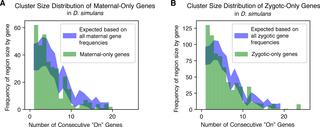当前位置:
X-MOL 学术
›
PLOS Genet.
›
论文详情
Our official English website, www.x-mol.net, welcomes your
feedback! (Note: you will need to create a separate account there.)
The conserved regulatory basis of mRNA contributions to the early Drosophila embryo differs between the maternal and zygotic genomes.
PLOS Genetics ( IF 4.0 ) Pub Date : 2020-03-30 , DOI: 10.1371/journal.pgen.1008645 Charles S Omura 1 , Susan E Lott 1
PLOS Genetics ( IF 4.0 ) Pub Date : 2020-03-30 , DOI: 10.1371/journal.pgen.1008645 Charles S Omura 1 , Susan E Lott 1
Affiliation

|
The gene products that drive early development are critical for setting up developmental trajectories in all animals. The earliest stages of development are fueled by maternally provided mRNAs until the zygote can take over transcription of its own genome. In early development, both maternally deposited and zygotically transcribed gene products have been well characterized in model systems. Previously, we demonstrated that across the genus Drosophila, maternal and zygotic mRNAs are largely conserved but also showed a surprising amount of change across species, with more differences evolving at the zygotic stage than the maternal stage. In this study, we use comparative methods to elucidate the regulatory mechanisms underlying maternal deposition and zygotic transcription across species. Through motif analysis, we discovered considerable conservation of regulatory mechanisms associated with maternal transcription, as compared to zygotic transcription. We also found that the regulatory mechanisms active in the maternal and zygotic genomes are quite different. For maternally deposited genes, we uncovered many signals that are consistent with transcriptional regulation at the level of chromatin state through factors enriched in the ovary, rather than precisely controlled gene-specific factors. For genes expressed only by the zygotic genome, we found evidence for previously identified regulators such as Zelda and GAGA-factor, with multiple analyses pointing toward gene-specific regulation. The observed mechanisms of regulation are consistent with what is known about regulation in these two genomes: during oogenesis, the maternal genome is optimized to quickly produce a large volume of transcripts to provide to the oocyte; after zygotic genome activation, mechanisms are employed to activate transcription of specific genes in a spatiotemporally precise manner. Thus the genetic architecture of the maternal and zygotic genomes, and the specific requirements for the transcripts present at each stage of embryogenesis, determine the regulatory mechanisms responsible for transcripts present at these stages.
中文翻译:

母体和合子基因组之间,mRNA对果蝇早期胚胎的保守调节基础有所不同。
驱动早期发育的基因产物对于在所有动物中建立发育轨迹至关重要。母体提供的mRNA促进了发育的最早阶段,直到受精卵可以接管其自身基因组的转录。在早期开发中,在模型系统中已经很好地表征了母本沉积和经酶促转录的基因产物。以前,我们证明了在果蝇属中,母本和合子的mRNA在很大程度上是保守的,但在种间也显示出惊人的变化,在合子阶段比母本阶段进化出更多差异。在这项研究中,我们使用比较方法来阐明孕产妇沉积和跨物种合子转录的调控机制。通过主题分析 我们发现与合子转录相比,与母体转录相关的调节机制有相当大的保守性。我们还发现活跃在母体和合子基因组中的调节机制是完全不同的。对于母本沉积的基因,我们发现了许多信号,这些信号通过富集于卵巢的因子而不是精确控制的基因特异性因子,在染色质状态水平上与转录调控相一致。对于仅由合子基因组表达的基因,我们发现了先前确定的调节子如Zelda和GAGA因子的证据,并进行了多项针对基因特异性调节的分析。观察到的调节机制与在这两个基因组中的已知调节一致:在卵子发生期间,优化了母体基因组,以快速产生大量转录本以提供给卵母细胞。在合子基因组激活后,采用机制以时空精确的方式激活特定基因的转录。因此,母本和合子基因组的遗传结构以及在胚胎发生每个阶段存在的转录本的具体要求,决定了在这些阶段存在的转录本的调控机制。
更新日期:2020-04-06
中文翻译:

母体和合子基因组之间,mRNA对果蝇早期胚胎的保守调节基础有所不同。
驱动早期发育的基因产物对于在所有动物中建立发育轨迹至关重要。母体提供的mRNA促进了发育的最早阶段,直到受精卵可以接管其自身基因组的转录。在早期开发中,在模型系统中已经很好地表征了母本沉积和经酶促转录的基因产物。以前,我们证明了在果蝇属中,母本和合子的mRNA在很大程度上是保守的,但在种间也显示出惊人的变化,在合子阶段比母本阶段进化出更多差异。在这项研究中,我们使用比较方法来阐明孕产妇沉积和跨物种合子转录的调控机制。通过主题分析 我们发现与合子转录相比,与母体转录相关的调节机制有相当大的保守性。我们还发现活跃在母体和合子基因组中的调节机制是完全不同的。对于母本沉积的基因,我们发现了许多信号,这些信号通过富集于卵巢的因子而不是精确控制的基因特异性因子,在染色质状态水平上与转录调控相一致。对于仅由合子基因组表达的基因,我们发现了先前确定的调节子如Zelda和GAGA因子的证据,并进行了多项针对基因特异性调节的分析。观察到的调节机制与在这两个基因组中的已知调节一致:在卵子发生期间,优化了母体基因组,以快速产生大量转录本以提供给卵母细胞。在合子基因组激活后,采用机制以时空精确的方式激活特定基因的转录。因此,母本和合子基因组的遗传结构以及在胚胎发生每个阶段存在的转录本的具体要求,决定了在这些阶段存在的转录本的调控机制。











































 京公网安备 11010802027423号
京公网安备 11010802027423号